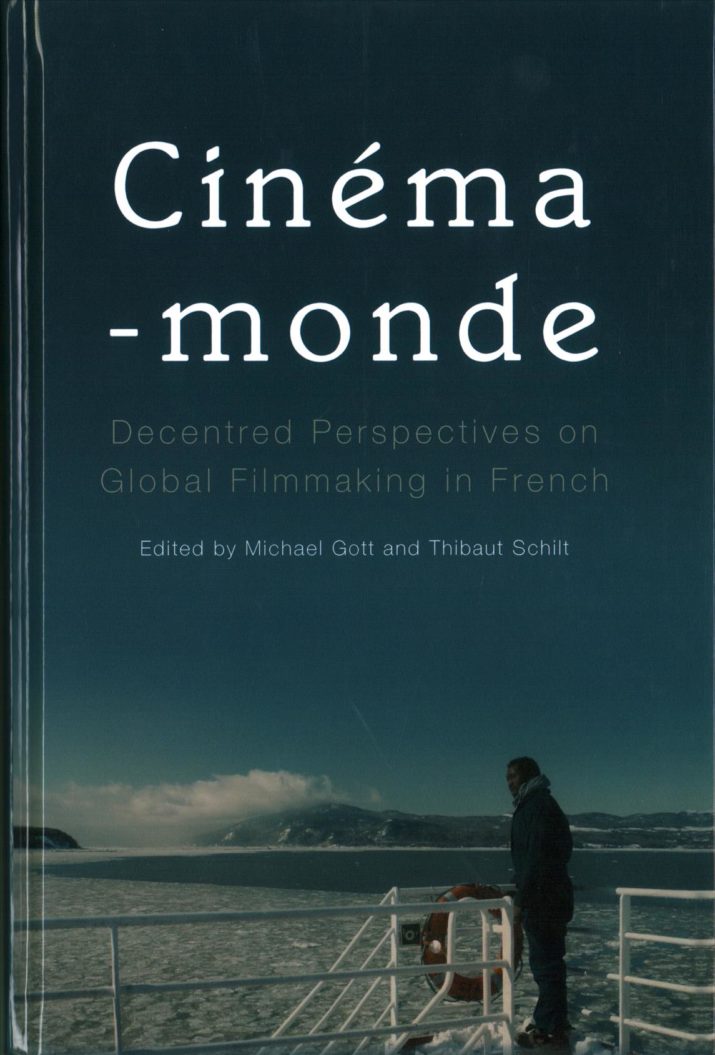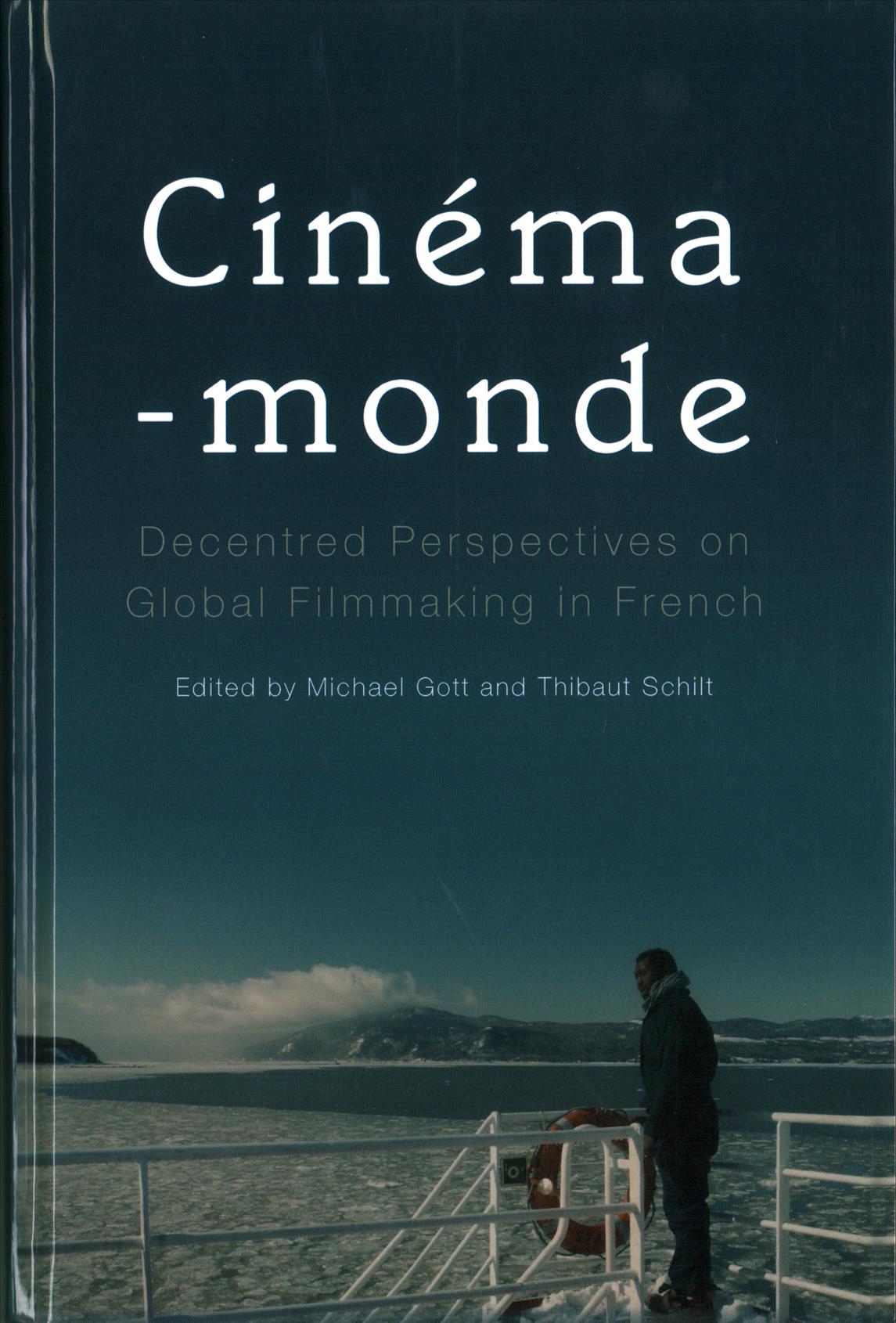
Cinéma-monde. Decentered Perspectives on Global Filmmaking in French edited by Michael Gott and Thibault Schilt

In their 2007 manifesto, “Pour une littérature-monde en français,” writers Michel Le Bris and Jean Rouaud announced to readers of Le Monde that a Copernican revolution had taken place but had yet to be acknowledged or named—the previous fall, writers hailing from beyond the hexagon had dominated France’s most prestigious literary prize competitions. The Goncourt for a First Novel and the Médicis Prize were awarded to Tunisians Hédi Kaddour and Sorj Chalandon, respectively; the Anglophone Canadian author Nancy Huston took the Femina Prize; the Renaudot went to Congolese novelist Alain Mabanckou; and Jonathan Littell, a Franco-American writer, walked away with both the Goncourt and Académie Française awards.
For the authors of the manifesto and its signatories (forty-four French-language writers hailing from various ethnic and national backgrounds), the message could not have been more obvious. French cultural hegemony had been unseated, the periphery had staked a claim in the center, and France had finally been stripped of its ultimate imperial possession: the French language. But the manifesto was perhaps most interested in delivering a mise-à-mort to Francophone literature—a fraught designation generally used to distinguish metropolitan (French) literature from the literary production of France’s former colonies. “Let’s be clear,” the authors of the manifesto urged, “the emergence of a consciously affirmed, transnational world literature in the French language, open to the world, signs the death certificate of so-called Francophone literature. No one speaks or writes ‘Francophone.’ Francophone literature is a light from a dying star.”
No one makes films in “Francophone,” either, and the new collection of essays edited by Michael Gott and Thibaut Schilt is keen to remind us of this. Cinéma-monde: Decentered Perspectives on Global Filmmaking in French resolutely eschews the Francophone in all its iterations (as an adjective, as a category), preferring instead to consider a corpus of global films as a cinéma-monde, a label that shares some conceptual DNA with Le Bris and Rouaud’s littérature-monde. Indeed, Gott, Schilt, and many of their contributors reject the category of Francophone for many of the same reasons put forth (explicitly or implicitly) in the 2007 manifesto: it drove a wedge between cultural productions from France and those emanating from the former French colonies, while also making it difficult to account for French-language production from non-colonial entities (Belgium, Switzerland) and internal French diversity. Inspired by Bill Marshall’s 2012 article, in which cinéma-monde is evoked in the interrogative (“Cinéma-monde? Toward a Concept of Francophone Cinema”), the editors of this volume have made it their task to turn Marshall’s question into a declarative statement.
Cinéma-monde, as it is conceived and explored in the book’s introduction, fourteen chapters, and three epilogues (penned by established French film scholars Lucy Mazdon, Will Higbee, and Bill Marshall himself), functions as “a critical framework or optic through which to approach a flexible corpus of films that are linked to the francophone world by some combination of linguistic or cultural affinities, geographic contacts, production connections, or reception networks” (2). Part heuristic tool, part sophisticated container, cinéma-monde is thus flexible enough to unite—under one marquee, as it were—directors from Algeria, Finland, and France, helming films set in Lévis, Liège, and London, and whose action takes place in Turkish, Tamil, Atikamekw (an indigenous language of Québec), and, also, in French.
Gott and Schilt bring together seventeen scholars with the goal of thinking through what we might call a “new world order” in contemporary French and Francophone cinema. Cinéma-monde recognizes that films are both art and products, and as such, it seeks to call our attention to the global entanglements of and in cinema. In a world of walls and bans, this collection makes an ethical commitment to valorizing mobility and the creation of connection. In taking up cinéma-monde as a critical framework and invoking metaphors of fluid margins (Iordanova and others), webs of connectedness (Shohat and Stam), kaleidoscopes, and the unmooring of French cinema from its national context, the editors are well aware that they are navigating in critical territory that has, to a degree, already been mapped. Thus, in their introduction, ample space is devoted to thinking through the convergences and divergences of cinéma-monde with other “de-centering” concepts such as Lionnet and Shih’s minor transnationalism, Naficy’s “accented cinema,” transnational cinema, and world cinema.
The collection is divided into three main sections whose foci could be described as “people,” “themes,” and “industry.” Each of the five essays that comprise the first part of the book focuses on a figure of cinéma-monde: directors Rithy Panh (of Cambodia) and Abderrahmane Sissako (who was born in Mauritania, but grew up in Mali) find themselves in the company of French filmmakers Rachid Bouchareb and Rachid Djaïdani (both of whom have roots in North Africa). This section is rounded out by a case-study essay devoted to Hafsia Herzi, the French actress of Maghrebi origin whose breakout performance culminated in an extended belly-dancing sequence at the end of Abedellatif Kechiche’s The Secret of the Grain (UK title: Couscous). In this essay, the author proposes to engage the question of cinéma-monde by analyzing the “local, national, transnational, and especially global dimensions of the career of one actress” (113). The second section features three essays that revolve around nodes or ideas: the sea journey as represented in a selection of francophone films; the representation and symbolic valences of soccer in African cinema; and the Québecois road movie. Of the two remaining essays, one examines the notion of “Europe” in the WWI historical drama Joyeux Noël, while the other brings into dialog the unlikely couple Samba (a French blockbuster starring Omar Sy and Charlotte Gainsbourg) and Le Havre (a stylized regional film by Finnish auteur Aki Kaurismäki). The essays of the third and final section primarily examine sites of filmmaking, be they geographic (Paris, Liège, West Africa) or administrative (France’s CNC, or National Film Center).
While cinéma-monde may carry with it a refreshing whiff of the “post-national,” Gott and Schilt’s introduction does not seek to engage with contemporary politics (nor do many of the essays); rather, the stakes of the volume’s intellectual agenda are situated within disciplinary debates that have become set pieces in French Studies. However, despite the book’s re-appropriation of the discursive gesture of the 2007 manifesto, the editors of Cinéma-monde have been careful not to turn the littérature-monde concept into a major touchstone (and most of the essays that refer to the manifesto do so fleetingly). Yet, in limiting its critical engagements with littérature-monde, the book perhaps unwittingly papers over the various critiques it engendered, side-stepping the analogous limits and pitfalls of cinéma-monde.
“Pour une littérature-monde en français” may have been one of the most written-about literary essays of the early twenty-first century (qualified as a “literary event” by Lydie Moudileno and others); it was, nonetheless, not without its detractors. A number of scholars viewed the manifesto and its “movement” as something of a publicity stunt; others accused the editors and signatories of reifying the very structures and dichotomies they sought to demolish. Still others observed that littérature-monde describes neither a praxis nor a methodology—and thus does not solve the problem of how we name a corpus.
Interestingly, in their cautious negotiations, Gott and Schilt decided not to take up a salient difference between cinéma- and littérature-monde; as a neologism created in 2007, the latter had never been used in its field prior to the manifesto. Cinéma-monde, however, is a term with a history: it has been used since the 1980s to describe power structures within the film industry. Writing in 1987, French economist Charles-Albert Michalet referred to Hollywood’s monolithic domination of cinema as “un cinéma-monde;” several decades later, Laroche and Bohas reprised Michalet’s term in the title of their study, Canal+ et les majors américaines, une vision désenchantée du cinéma-monde [Canal+ and the Major American Studios: A Disappointed Vision of the Cinéma-monde] (Paris, L’Harmattan, 2008). These notions of cinéma-monde not only predate the Gott and Schilt volume, they also precede Marshall’s use of the term in 2012. More to the point, however, these earlier iterations of the notion refer to something utterly different than what Marshall, Gott, and Schilt are attempting to articulate. The “cinéma-monde” identified by Michalet is a self-contained, dominating world formation, far closer to Braudel’s notion of an autonomous économie-monde, than to the de-centered, multi-sited, transnational network of exchanges and links that Cinéma-monde strives to create.
A thoroughgoing exploration of how the “-monde” formulation has been appropriated (or ‘in-appropriated’) is both necessary and a topic for another time and a different essay. And notwithstanding the element of “category fatigue” humming in the background of these comments, it bears stating that we should always, of course, question our terms, paradigms, and methods, and that attempts to invert or even just unsettle existing power structures are necessarily salutary and to be applauded. However, it is worth observing, by way of conclusion, that the most salient lesson in Cinéma-monde, and the one most relevant for reading a complex, variegated body of film, prompts us to look away from the global. Mireille Rosello’s excellent essay on the films of Franco-Algerian director Rachid Bouchareb makes a passionate argument for reading film for its details, for its grammar, for the ideas and symbols embedded in its grain. Discussing specifically the representation of global terrorism in Bouchareb’s London River, Rosello laments the proliferation of readings that rely exclusively on the film’s plot, and thus lead to assessments of the work as “predictable, didactic or too politically correct” (47). She exhorts us, rather, to watch film politically—by which she means “obliquely”—focusing on “the framing device rather than the plot, and on details rather than the global picture” (48). Could looking away from the “-monde” paradoxically be an answer to better understanding it?
Lia Brozgal is Associate Professor of French and Francophone Studies at the University of California Los Angeles UCLA, where she is affiliated with the Leve Center for Jewish Studies and the African Studies Master of Arts program. Recent publications include essays on race in French cinema, on French documentary film, and on narratives of the German occupation of colonial Tunisia. She is looking forward to the publication of a monograph on the cultural representations of the October 1961 Parisian police massacre of Algerian protesters (under contract with Liverpool University Press) and of the English translation of Leïla Sebbar’s omnibus volume Une enfance juive en Méditerranée musulmane.
Cinéma-monde. Decentered Perspectives on Global Filmmaking in French
Edited by Michael Gott and Thibault Schilt
Publisher: Edinburgh University Press
Hardcover / 378 pages / 2018
ISBN: 978-1474414982
To read more book reviews click here.
Published on September 10, 2019.
References
Marshall, Bill. “Cinéma-monde? Toward a Concept of Francophone Cinema.” Francosphères1 (1), pp. 35-51. http://liverpool.metapress.com/content/k233201517l1/?p=1bf2230f636844c7b4c725b1d3bcfbcfπ=0; https://doi.org/10.3828/franc.2012.3




